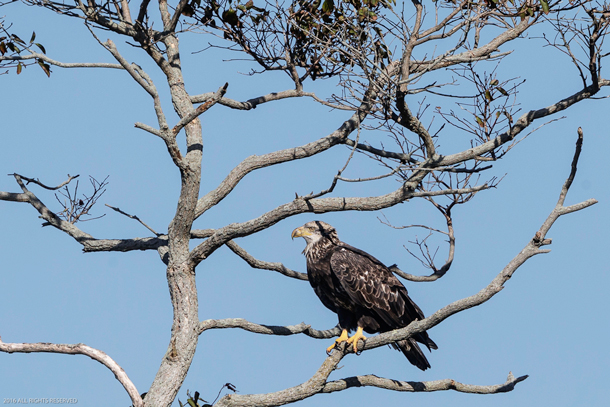Field Note: Eagles At Play
Published: April 13, 2018
By Mark Seth Lender

A juvenile bald eagle perched in a tree (Photo: Mark Seth Lender)
In this field note, Living on Earth’s Explorer-in-Residence Mark Seth Lender remarks on the powerful hold the American Bald Eagle has on our collective awe, and on how severely we have decimated their numbers in the centuries since Europeans landed on North America’s shores.
The first time you see an adult bald eagle an image is painted in the mind’s eye, the white head, the great wings beating in their slow and powerful way like the single rower in an Eakins painting. And each and every time thereafter it is that first vision, recalled. We seldom stop to question why we feel this way. At least part of the answer is rara avis; literally “Rare Bird.”
Some people will tell you eagles are doing fine. There are plenty. It’s just fine if wind power kills a hundred; five hundred. Or they will claim, as they do, that in some places bald eagles are a pestilence. Are we to be reassured? Enough to deny our own remarkable experience?
Before European contact there were bald eagles in North American by the hundreds of thousands. They were poisoned (advertently as pests, inadvertently by DDT), shot because ranchers thought they took livestock (they don’t) or for sport, or both; had their habitat destroyed. And the number of bald eagles plummeted. With the banning of DDT, and deliberate eradication of eagles constrained, the population rebounded. But by how much? Ten percent of what they were before? Twenty? Our perception of the eagle as exceptional rings true. In more ways than one.
LINK: Listen to the “Bald Eagles At Play” essay
Back to Mark Seth Lender Field Notes
Living on Earth wants to hear from you!
Living on Earth
62 Calef Highway, Suite 212
Lee, NH 03861
Telephone: 617-287-4121
E-mail: comments@loe.org
Newsletter [Click here]
Donate to Living on Earth!
Living on Earth is an independent media program and relies entirely on contributions from listeners and institutions supporting public service. Please donate now to preserve an independent environmental voice.
NewsletterLiving on Earth offers a weekly delivery of the show's rundown to your mailbox. Sign up for our newsletter today!
 Sailors For The Sea: Be the change you want to sea.
Sailors For The Sea: Be the change you want to sea.
 The Grantham Foundation for the Protection of the Environment: Committed to protecting and improving the health of the global environment.
The Grantham Foundation for the Protection of the Environment: Committed to protecting and improving the health of the global environment.
 Contribute to Living on Earth and receive, as our gift to you, an archival print of one of Mark Seth Lender's extraordinary wildlife photographs. Follow the link to see Mark's current collection of photographs.
Contribute to Living on Earth and receive, as our gift to you, an archival print of one of Mark Seth Lender's extraordinary wildlife photographs. Follow the link to see Mark's current collection of photographs.
 Buy a signed copy of Mark Seth Lender's book Smeagull the Seagull & support Living on Earth
Buy a signed copy of Mark Seth Lender's book Smeagull the Seagull & support Living on Earth

